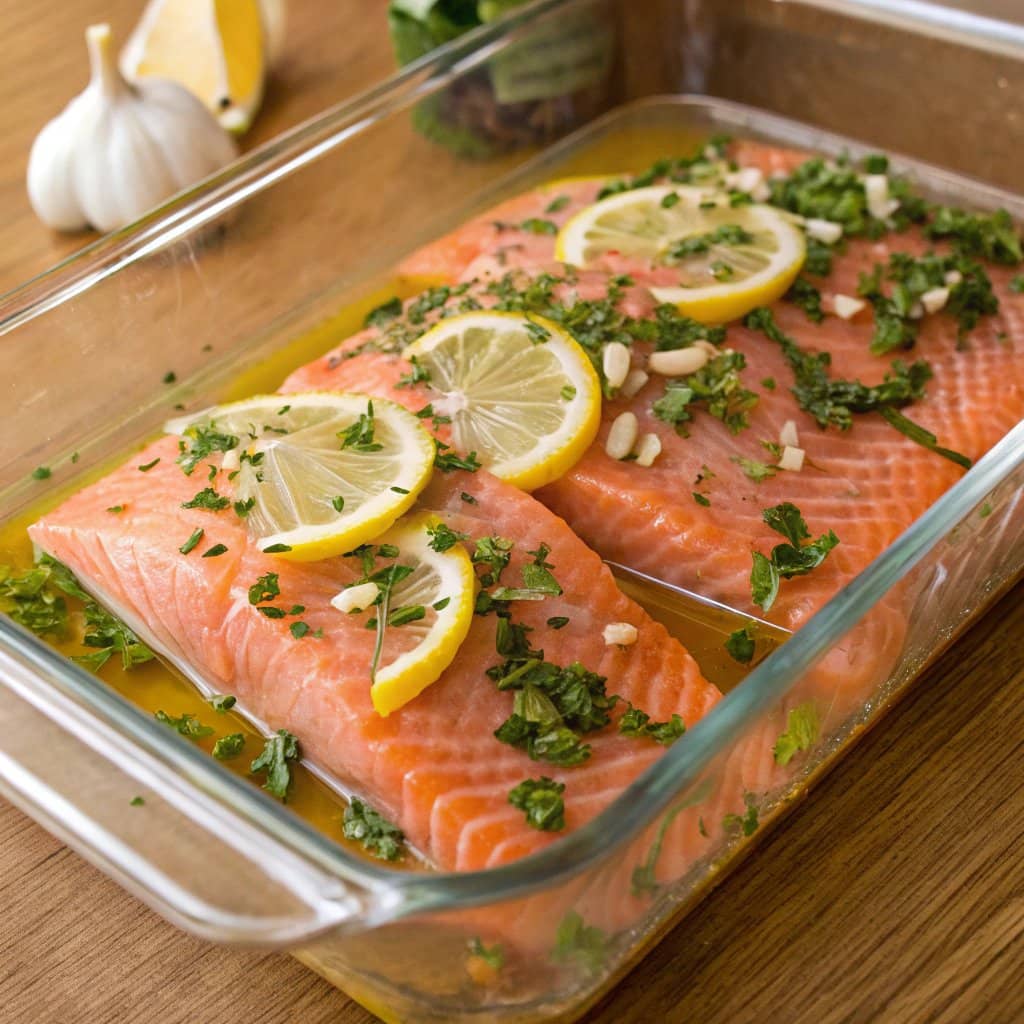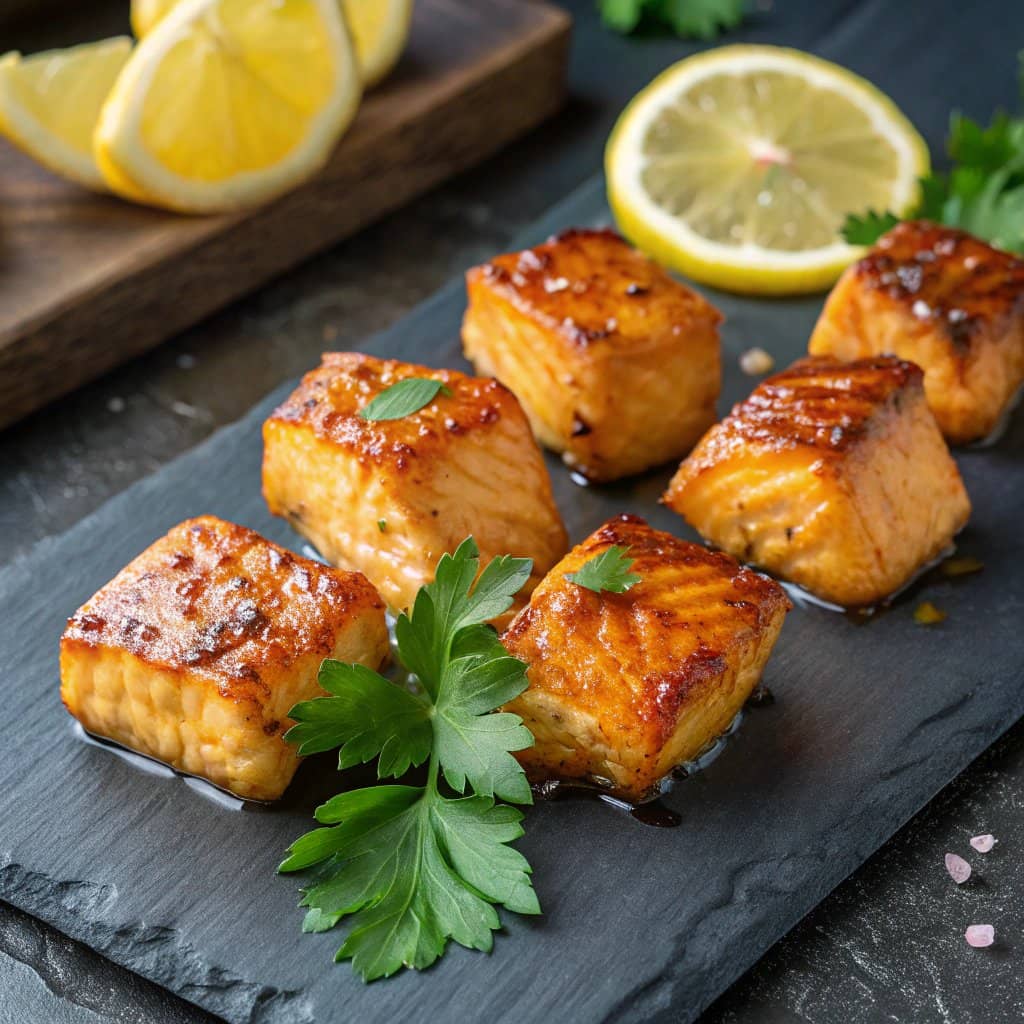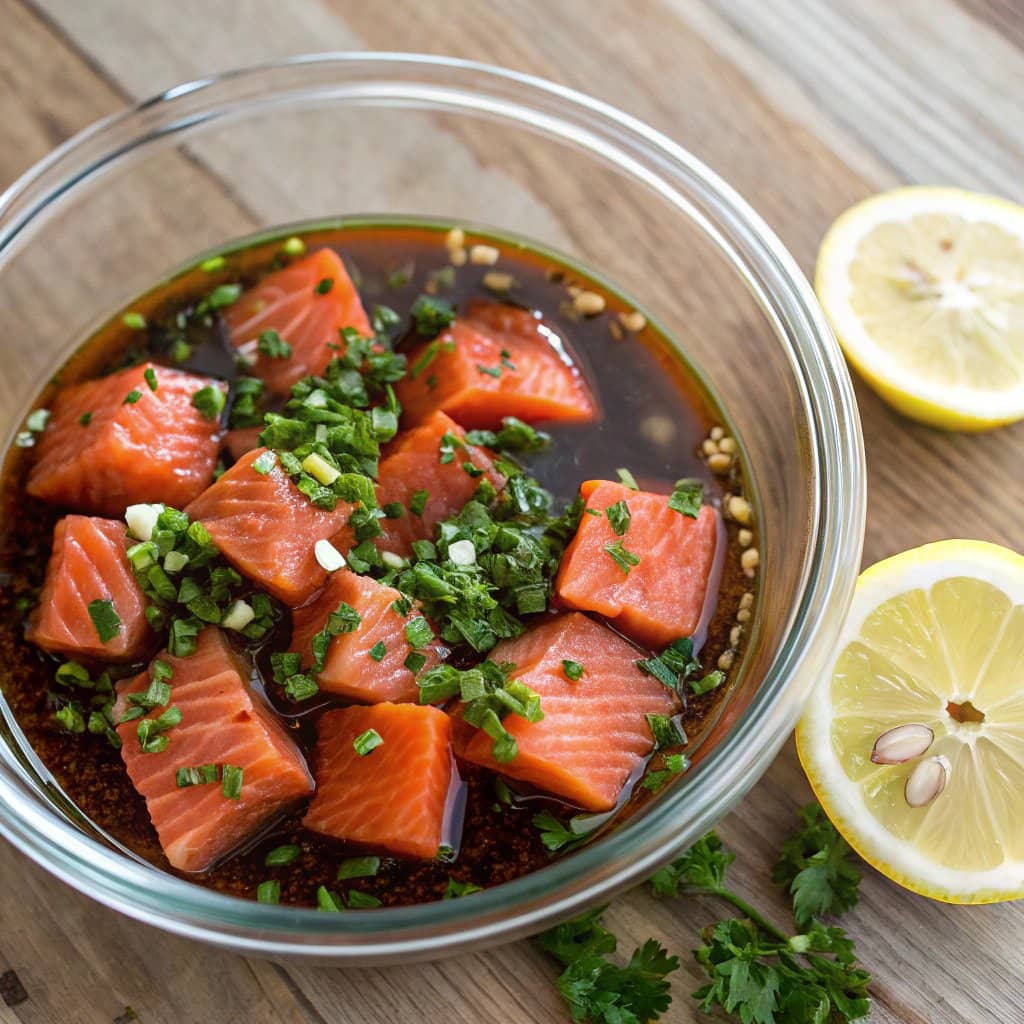Salmon is a popular and delicious fish that’s packed with nutrients like omega-3 fatty acids and protein. But before cooking, many people wonder, “What do you soak salmon in to make it taste even better?” Soaking salmon can enhance its flavor, improve its texture, and remove any unwanted fishy odors.
This article will guide you through the best soaking techniques, ingredients to use, and why soaking is a great step to prepare salmon. If you’ve ever asked, “What do you soak salmon in before cooking?”, you’re not alone—this simple step can transform the flavor and texture of your fish. Whether you’re grilling, baking, or pan-searing your fish, understanding what do you soak salmon in before cooking will help you create a meal that’s both tasty and unforgettable. Let’s dive into the secrets of soaking salmon!
What Soaking Does for Salmon
Enhances the Flavor
Soaking salmon in a marinade or brine adds delicious flavors that complement its natural richness. Ingredients like citrus, soy sauce, or herbs seep into the fish, making each bite more flavorful and satisfying.
Reduces the Fishy Smell
If the smell of salmon feels overpowering, soaking it can help. Using acidic ingredients like lemon juice or vinegar can neutralize the fishy odor. Milk is another popular choice that removes the smell while keeping the fish moist and tender.
Improves the Texture
Soaking salmon in a brine helps break down proteins, which results in a tender, flaky texture. This step is especially important if you’re cooking methods like grilling or baking, where achieving the perfect texture can be tricky.
Prevents Overcooking
A good soak creates a moisture barrier around the fish, preventing it from drying out. This is particularly helpful when cooking salmon on high heat, such as broiling or grilling.
Common Ingredients for Soaking Salmon
Saltwater Brine: A Simple Classic
A saltwater brine is one of the easiest and most effective ways to soak salmon. By mixing water with salt, you create a solution that enhances the fish’s natural flavor while improving its texture. The salt breaks down proteins in the fish, making it tender and juicy.
- How to Make a Brine: Combine 1 tablespoon of salt with 1 cup of water. Adjust the quantity depending on the size of your salmon. Soak the fish for 10–20 minutes before cooking.
- Best Use: Brining is ideal for grilling or roasting, as it helps retain moisture under high heat.
Lemon Juice or Vinegar: Adding Acidity
Acidic ingredients like lemon juice or vinegar are great for balancing the rich, oily flavor of salmon. These ingredients not only enhance taste but also help remove any fishy smell.
- How to Use Lemon or Vinegar: Combine 2–3 tablespoons of lemon juice or white vinegar with 1 cup of water. Let the salmon soak for 10–15 minutes.
- Best Use: This works well for baking or pan-searing, as it adds brightness to the dish.
Sweet Additions: Honey or Maple Syrup
Adding a touch of sweetness to your soaking solution can create a delightful balance of flavors. Honey or maple syrup pairs well with salmon’s natural taste, making it a favorite for many.
- How to Use Sweet Ingredients: Mix 2 tablespoons of honey or maple syrup with water or soy sauce for a marinade. Soak for 20–30 minutes for the best results.
- Best Use: Sweet marinades are perfect for grilling or broiling, as the sugars caramelize beautifully.
Herbs and Spices: Aromatic Enhancements

Fresh herbs like dill, parsley, or thyme, along with spices like garlic or paprika, can infuse salmon with layers of flavor. These ingredients add depth without overpowering the fish’s natural taste.
- How to Use Herbs and Spices: Add a handful of fresh herbs or a teaspoon of spices to your soaking solution or marinade. Let the fish sit for 20–30 minutes.
- Best Use: Use this method for versatile cooking styles, including roasting and smoking.
Soy Sauce or Teriyaki: A Savory Twist
For a savory, umami-rich flavor, soy sauce or teriyaki is an excellent choice. These ingredients not only add saltiness but also bring out the natural flavor of the salmon.
- How to Use Soy Sauce: Mix 2–3 tablespoons of soy sauce with water or citrus juice. Let the salmon soak for 15–30 minutes.
- Best Use: This marinade is ideal for Asian-inspired dishes or stir-frying.
Step-by-Step Guide to Soaking Salmon
Soaking salmon may sound simple, but following a structured process ensures the best results. Here’s how to soak your salmon like a pro:
- Prepare Your Ingredients: Choose your soaking solution—whether it’s a saltwater brine, lemon juice mix, or soy-based marinade.
- Mix the Solution: Combine the ingredients in a bowl or dish large enough to submerge the salmon completely.
- Submerge the Salmon: Place the salmon fillets in the soaking liquid, ensuring they are fully covered. For thicker fillets, flip them halfway through the soak.
- Set the Timer: Depending on the ingredients, soaking times vary. Brines may only require 10–15 minutes, while marinades can take up to 30 minutes.
- Rinse (If Necessary): After soaking, lightly rinse the salmon under cold water if using a salty or acidic solution. This prevents overly intense flavors.
Ideal Soaking Times Based on Ingredients
Timing is key when soaking salmon. Over-soaking can result in an overpowering taste or mushy texture.
- Saltwater Brine: 10–20 minutes.
- Lemon Juice or Vinegar: 10–15 minutes.
- Soy Sauce or Teriyaki: 15–30 minutes.
- Herbs and Spices: 20–30 minutes for optimal infusion.
- Milk: Up to 30 minutes for odor neutralization.
Common Mistakes to Avoid
- Over-Soaking: Leaving salmon in the solution for too long can make it overly salty, acidic, or mushy.
- Using Too Much Acid: A highly acidic solution can “cook” the fish, similar to ceviche, and alter the texture before you cook it.
- Skipping the Rinse: If the soaking solution is very strong, failing to rinse the salmon can result in an overpowering taste.
- Neglecting Freshness: Soaking won’t fix fish that isn’t fresh. Always use high-quality salmon for the best results.
Pro Tip for Beginners
If you’re new to soaking salmon, start with a simple saltwater brine. It’s easy, quick, and delivers consistently delicious results. Once you’re comfortable, experiment with different marinades to suit your taste preferences.
Popular Marinades for Salmon

Lemon and Herb Marinade
A bright, refreshing classic.
- Ingredients: Lemon juice, olive oil, garlic, parsley, salt, and pepper.
- Soaking Time: 20–30 minutes.
- Best For: Baking or grilling.
Soy Sauce and Ginger Marinade
Savory with a hint of spice.
- Ingredients: Soy sauce, ginger, garlic, sesame oil, and honey.
- Soaking Time: 15–30 minutes.
- Best For: Broiling or pan-searing.
Honey Mustard Marinade
Sweet meets tangy.
- Ingredients: Honey, Dijon mustard, olive oil, and paprika.
- Soaking Time: 20–30 minutes.
- Best For: Grilling or baking.
Maple and Soy Glaze
Rich and bold with caramelized sweetness.
- Ingredients: Maple syrup, soy sauce, garlic, and lime juice.
- Soaking Time: 15–25 minutes.
- Best For: Broiling or pan-searing.
Coconut Lime Marinade
Tropical and creamy.
- Ingredients: Coconut milk, lime juice, ginger, and cilantro.
- Soaking Time: 20–30 minutes.
- Best For: Grilling or steaming.
Does Every Salmon Need Soaking?
Wild-Caught vs. Farm-Raised Salmon
The type of salmon you choose determines whether soaking is necessary:
- Wild-Caught Salmon: Typically has a clean, fresh taste and firm texture, often requiring little to no soaking.
- Farm-Raised Salmon: Can have a slightly fishier smell or softer texture, making soaking helpful for flavor enhancement and odor removal.
When Soaking Isn’t Necessary
Not all recipes call for soaking. Skip this step if:
- The salmon is exceptionally fresh and already flavorful.
- You’re using a dry rub or seasoning blend instead of a marinade.
- You prefer the fish’s natural taste without added flavors.
When Soaking is Essential
Soaking is especially important for:
- Frozen Salmon: Helps refresh texture and remove any freezer odors.
- Strong-Flavored Marinades: Ensures the flavor is evenly distributed.
- Cooking Techniques Like Smoking: Pre-soaking adds moisture and prevents drying out.
You Might Also Like
Looking for more delicious ideas to complement your salmon dishes? Check out these exciting recipes and unique culinary adventures:
- Salmon Bites Recipes: Discover bite-sized salmon creations perfect for appetizers or quick meals. Packed with flavor, these recipes are a must-try!
- Bang Bang Sauce: This creamy, spicy, and slightly sweet sauce pairs perfectly with salmon bites or as a dipping sauce for other seafood dishes.
- Bolognese Ice Cream: Feeling adventurous? Indulge in this unique twist on a classic Italian dish. It’s a surprising treat for the bold foodie!
Frequently Asked Questions
Do You Rinse Salmon After Soaking?
Yes, lightly rinse salmon after soaking, especially if using a salty or acidic solution. This prevents overly strong flavors while retaining the marinade’s benefits.
Can You Soak Salmon in Milk?
Absolutely! Milk is great for neutralizing fishy odors and enhancing texture. Soak for about 20–30 minutes for the best results.
What’s the Best Soaking Time for Salmon?
It depends on the method:
- Saltwater Brine: 10–20 minutes.
- Marinades: 15–30 minutes.
Over-soaking can lead to mushy texture, so stick to these guidelines.
Is Soaking Necessary for Smoked Salmon?
Yes, for hot smoking, soaking adds moisture and flavor while preventing the fish from drying out. For cold smoking, brining is essential to preserve the fish.
Can You Reuse Marinade for Other Fish?
No, it’s unsafe to reuse marinade that has come into contact with raw fish. However, you can boil it to kill bacteria if you want to use it as a sauce.
What’s the Best Ingredient to Remove Fishy Smells?
Lemon juice, vinegar, or milk work wonders for neutralizing strong fish odors. A short soak in any of these will leave your salmon fresh and odor-free.
Conclusion
Soaking salmon before cooking is a simple yet powerful way to elevate its flavor, texture, and overall quality. Many people ask, “What do you soak salmon in before cooking?” From classic saltwater brines to creative marinades like soy sauce and ginger or honey mustard, the possibilities are endless. Soaking not only enhances taste but also neutralizes odors and helps the fish retain moisture during cooking.
While not all salmon requires soaking, understanding what to soak salmon in before cooking can make a noticeable difference, especially with farm-raised or frozen fish. Whether you’re grilling, baking, or pan-searing, following the right soaking techniques ensures your salmon turns out tender, flavorful, and perfectly cooked.
By asking, “What do you soak salmon in before cooking?”, you open up a world of preparation options. The right marinade or brine can infuse the fish with incredible flavors while improving its texture. From tangy lemon herb marinades to savory soy-based options, the choice depends on your taste preferences.
Now that you know what to soak salmon in before cooking, you’re ready to create delicious meals that everyone will love. Experiment with different techniques to find your favorite flavor combinations, and enjoy the process. Happy cooking!

